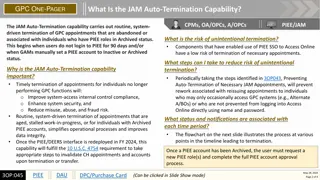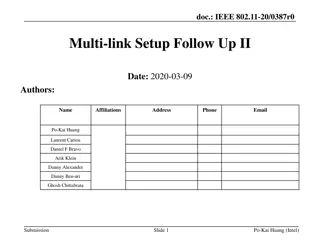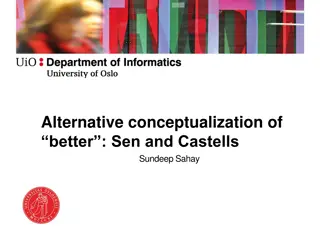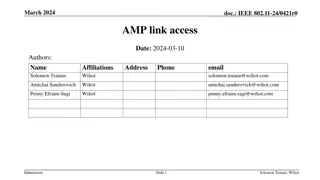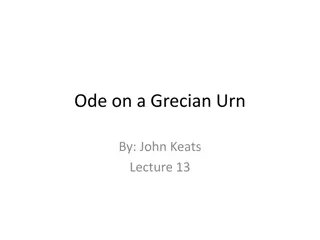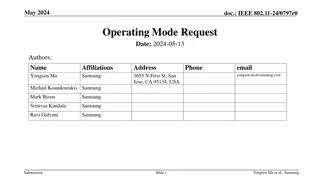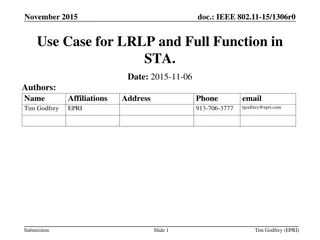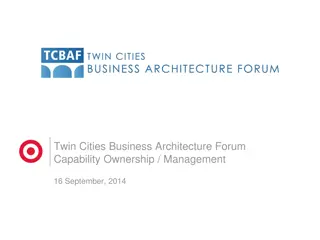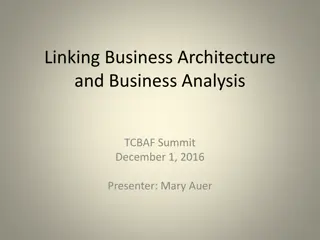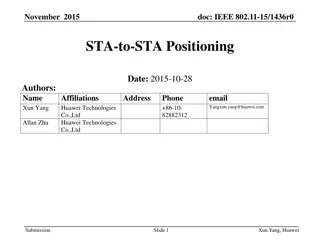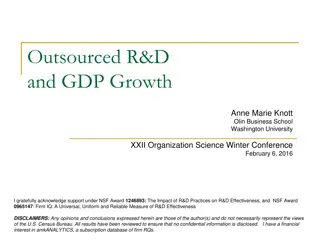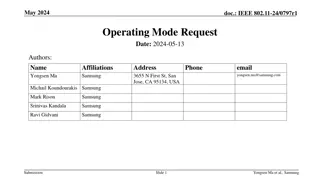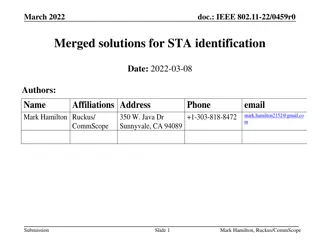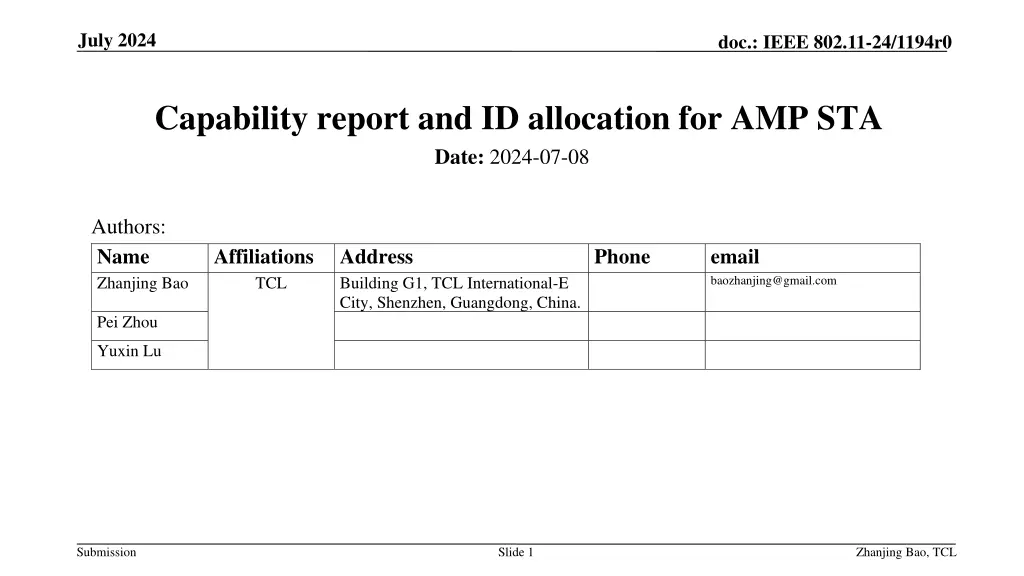
IEEE 802.11-24: AMP STA Capability Report & ID Allocation
Discussing the necessity of reporting AMP capabilities and allocating IDs for AMP STAs in IEEE 802.11-24. It covers the background, abstract, fast authentication, association in 11ah, and the importance of capability reporting for different types of AMP STAs. The document emphasizes the need for different channel access methods based on the capabilities of AMP devices.
Download Presentation

Please find below an Image/Link to download the presentation.
The content on the website is provided AS IS for your information and personal use only. It may not be sold, licensed, or shared on other websites without obtaining consent from the author. If you encounter any issues during the download, it is possible that the publisher has removed the file from their server.
You are allowed to download the files provided on this website for personal or commercial use, subject to the condition that they are used lawfully. All files are the property of their respective owners.
The content on the website is provided AS IS for your information and personal use only. It may not be sold, licensed, or shared on other websites without obtaining consent from the author.
E N D
Presentation Transcript
July 2024 doc.: IEEE 802.11-24/1194r0 Capability report and ID allocation for AMP STA Date: 2024-07-08 Authors: Name Zhanjing Bao Affiliations TCL Address Building G1, TCL International-E City, Shenzhen, Guangdong, China. Phone email baozhanjing@gmail.com Pei Zhou Yuxin Lu Submission Slide 1 Zhanjing Bao, TCL
July 2024 doc.: IEEE 802.11-24/1194r0 Background As stated in the 802.11bp PAR[1], 11bp amendment defines mechanisms for the coexistence of an AMP STA and deployed STAs in the same frequency. There are couple of contributions [2] - [4] discussed the different PHY capabilities of AMP STAs. In [5], different scenarios with or without associations are mentioned when discussing the MAC design of AMP. Considering the implementation of relay, both AP(soft AP) and non-AP STA can serve as readers Submission Slide 2 Zhanjing Bao, TCL
July 2024 doc.: IEEE 802.11-24/1194r0 Abstract In this contribution, we discuss the necessity of AMP capability reporting and the method of ID allocation for AMP STAs with storage capacity - which allows the reader to learn about the AMP STA s existence and capabilities - which is beneficial for achieving grouping access and access restrictions in IoT scenarios with large-scale devices Submission Slide 3 Zhanjing Bao, TCL
July 2024 doc.: IEEE 802.11-24/1194r0 Recap-Fast Authentication and Association in 11ah In Centralized Authentication Control (CAC), the AP dynamically changes the portion of stations that are allowed to send AuthReq messages. - a CAC AP sets a threshold and broadcasts it to all stations, and a CAC STA shall generate a random value from the interval [0, 1022], and tries to send an AuthReq to the AP if the random value is smaller than the threshold obtained from the received beacon. In Distributed Authentication Control (DAC), a beacon interval is divided into sub-intervals called Authentication Control Slots (ACSs). - Stations randomly select a beacon interval and a ACS to send their AuthReq. Submission Slide 4 Zhanjing Bao, TCL
July 2024 doc.: IEEE 802.11-24/1194r0 The necessity of capability reporting During the study group stage, we discussed AMP-only devices and AMP- assisted devices based on different use cases[6] AMP-assisted devices tend to achieve compatibility and coexistence with legacy STAs, and further reduce power consumption through environmental energy harvesting, while AMP-only devices may have active transmitters or just transmit through backscatter There should be different channel access methods for different AMP STAs, and the reader should obtain the capability information of the AMP STA before initiating scheduling Submission Slide 5 Zhanjing Bao, TCL
July 2024 doc.: IEEE 802.11-24/1194r0 AMP STA capability report For AMP STAs which are unable to initiate transmission through EDCA, the AMP STA capability collection should be initiated by the reader. The Reader broadcasts trigger frame to initiate the capability collection, indicating the protection window AMP STAs send response frame with capability fields or element to report its device capability information - The content of capability information needs further discussion - Further discussion is needed on the channel access methods for the response frame, such as TDMA, FDMA, etc Identify protection window trigger reader response AMP STA #1 Not allowed to access Legacy STA Based on capability reporting, the reader can further assign IDs to AMP STAs which can store the ID for grouping or allocation of transmission resources. AMP STAs which can obtain transmission opportunities on their own can follow the existing association way. Submission Slide 6 Zhanjing Bao, TCL
July 2024 doc.: IEEE 802.11-24/1194r0 AP as reader-ID allocation method a AP broadcasts trigger frame to initiate capability collection, indicating the protection window - AMP STA do not need to send request frame through EDCA protection window slot1 slot2 Trigger ID allocation Trigger ID allocation READER Response AMP STA #1 AMP STAs send response frame with its capabilities Response AMP STA #2 AP assigns an ID to the AMP STA that successfully sent a response frame, like AID in 11ah Within the protection window, the reader can repeatedly send trigger frames, and the AMP STA received the ID does not need to respond to subsequent trigger frames SP or TXOP or Identification slot 2 ID allocation Identification slot n ID allocation Identification slot 1 ID allocation Submission Slide 7 Zhanjing Bao, TCL
July 2024 doc.: IEEE 802.11-24/1194r0 AP as reader-ID allocation method b AP broadcasts trigger frame to initiate capability collection, and AMP STA send response frame like method a. protection window slot1 slot2 ack Trigger ack ID allocation Trigger Unlike method a, AP does not need to assign an ID immediately after receiving feedback from AMP STA, and shall send an ack to it -the AMP STA received ack will not intend to respond again subsequent trigger frames READER Response AMP STA #1 Response AMP STA #2 SP or TXOP... After multiple triggers, the AP can uniformly allocate IDs For both method a and b, if no feedback is received after multiple triggers, AP could terminate the protection window in advance Identification slot n ID allocation Identification slot 1 Identification slot 2 Submission Slide 8 Zhanjing Bao, TCL
July 2024 doc.: IEEE 802.11-24/1194r0 non-AP STA as reader-ID allocation method c AP reader AMP STA AMP STA Capability collection can be initiated by the reader or AP Identification initiated trigger The reader sends identification triggers to collect feedback from AMP STAs, similar to method b The reader reports the information of AMP STA to the AP. AP assigns IDs and forwards them to AMP STAs through a reader response ack Protection window trigger response ack AMP STA info report Based on MLO, the link between AP and reader does not have to be in the 2.4G or S1G frequency band ID allocation ID allocation Submission Slide 9 Zhanjing Bao, TCL
July 2024 doc.: IEEE 802.11-24/1194r0 Summary We discussed the necessity and methods of AMP STAs reporting capability to the reader Based on the capability report, we proposed several methods for ID allocation of AMP STAs, which helps readers obtain the capability information of AMP STAs and perform group access or access restrictions, thereby reducing conflicts caused by large-scale device access. We plan to further discuss the channel access schemes based on different AMP STAs capabilities and corresponding MAC frame formats in the future Submission Slide 10 Zhanjing Bao, TCL
July 2024 doc.: IEEE 802.11-24/1194r0 SP1 Do you agree that AMP STAs should report device capability information to readers Note: The detailed capability information is TBD. Y/N/A Submission Slide 11 Zhanjing Bao, TCL
July 2024 doc.: IEEE 802.11-24/1194r0 SP2 Do you agree to assign an ID to the AMP STA that can support storing parameters assigned by the reader Note: The detailed ID allocation process and related frame formats are TBD. Y/N/A Submission Slide 12 Zhanjing Bao, TCL
July 2024 doc.: IEEE 802.11-24/1194r0 References [1] 11-24-0575-01-0amp-p802-11bp-par [2] 11-24-0849-00-00bp-harmonization-of-waveform [3] 11-24-0867-00-00bp-thoughts-and-questions-on-amp-phy [4] 11-24-0853-00-00bp-design-target-and-device-capabilities-for-amp-iot [5] 11-24-0872-00-00bp-mac-aspects-for-amp [6] 11-23-2203-01-0amp-updated-technical-report-on-support-of-amp-iot- devices-in-wlan Submission Slide 13 Zhanjing Bao, TCL

